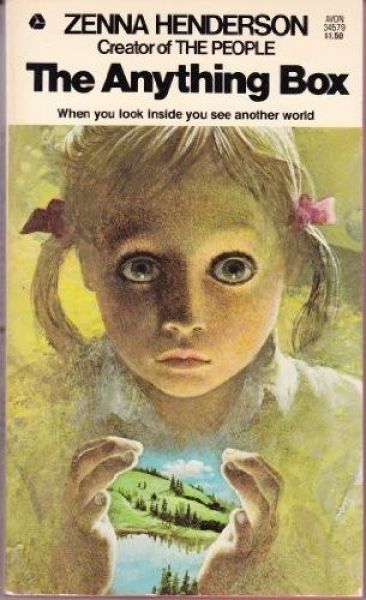They Bite
The Anything Box
By Zenna Henderson

14 Apr, 2024
Zenna Henderson’s 1965 The Anything Box is a collection of short speculative fiction stories.
Henderson is best remembered for her People stories, since collected in NESFA Press’s Ingathering. The People sequence formed only a fraction of Henderson’s work. The Anything Box collects a cross-section of her non-People work.
Readers may recognize a couple of these stories. While her People stories might now be her best-remembered works, her other fiction was well regarded at the time. Three stories (“The Anything Box,” “Subcommittee,” and “Something Bright”) were selected for Merril’s Best S‑F anthologies.
Henderson’s preferred setting is a rural community on Earth. The stories are often told from the perspective of an adult in charge of children. Presumably, this reflects Arizona-born teacher Henderson’s own background. Wonders abound in these stories: viewed with glee or awe by children, with mixed feelings by adults. The adults might be better served if they could greet some of these wonders with childlike fascination… but not always.
The teachers in these stories are sometimes loving mentors, sometimes nuisances to be avoided or managed.
Trillion Year Spree commented that Henderson “Out-Simaks Simak.” I take it to mean that just as Simak stories are often comforting tales of human-alien friendship, many Henderson stories are also comfort reads. But not all. Some of the stories in The Anything Box (such as “Hush” and “The Last Step”) are much darker than anything Simak ever wrote.
I’ve seen Henderson’s stories described as “pre-feminist.” While the women in her stories tend to have traditional Eisenhower-era roles such as housewife or teacher, one cannot help but notice that unlike many of her contemporaries, Henderson is happy to make the women the focus of the stories. Their work has consequences. They aren’t the arm candy, housewives, menials, or other female supporting characters featured in so much of the fiction of the time.
The Anything Box is long out of print but NESFA Press offers two collections by Henderson, the second of which, Believing, collects Henderson’s non-People stories.
A short look at each story.
“The Anything Box” • (1956) • short story
An officious teacher pretends to take from a distracted student the imaginary treasure that the student cherishes. The teacher discovers her error when it is almost too late to fix it.
Subcommittee • (1962) • novelette
While Very Serious Men try and fail, it falls to a housewife to bridge the gap between human and alien.
“Something Bright” • (1960) • short story
A Depression-era young girl helps her elderly neighbor find her destiny.
“Hush!” • (1953) • short story
A child’s fantasy proves horrifyingly real.
“Food to All Flesh” • (1953) • short story
A priest struggles with first contact. Visitors should be fed — but what exactly do the newcomers eat?
“Come On, Wagon!” • (1951) • short story
A child-loathing adult tries to harness the power of childlike wonder… too late.
This is one of two stories that begin with the adult proclaiming their dislike of children.
“Walking Aunt Daid” • (1955) • short story
A young man discovers the horrifying secret behind Aunt Daid’s unnaturally extended life.
“The Substitute” • (1953) • short story
Whether young Keeley is profoundly cognitively impaired or simply self-destructively antisocial is an open question. Either way, there seems to be no future for him on Earth…. Not on Earth, anyway.
While this story reflects 1950s views on managing what we now call neurodiverse students, Henderson makes a point that there is a lot more going on in Keeley’s head than his teachers are able or willing to recognize.
“The Grunder” • (1953) • short story
Is there a cure for irrational bursts of jealousy?
“Things” • (1960) • short story
The off-world Strangers offer novelties. To embrace them is to embrace death… or a fate worse than death.
This would fit nicely into an anthology of Eisenhower-era American SF authors grappling with colonialism.
“Turn the Page” • (1957) • short story
What happens after a teacher leaves? She has opened her students’ eyes to wonder. Will they forget?
You could see this as a depressing sequel to The Magic School Bus.
Stevie and the Dark • (1952) • short story
A small child improvises magic to contain evil. His efforts are very nearly sufficient.
And a Little Child— • (1959) • short story
Adults cheerfully dismiss a child’s fanciful descriptions of the world around them. They would have done better to take heed.
“The Last Step” • (1958) • short story
An officious teacher does her best to stamp out every shred of imagination, creativity, and other deviance from the colonial children unfortunate enough to fall under her care. Her efforts produce results, although not the ones she wanted.
This would be the other story in this collection that begins with an adult proclaiming their dislike for children. The fault is never on the child’s side. It would have been interesting to see Henderson’s take on The Lord of the Flies.
